News
‘Laura’s Law’ okayed in 30 counties — a major statewide turnaround
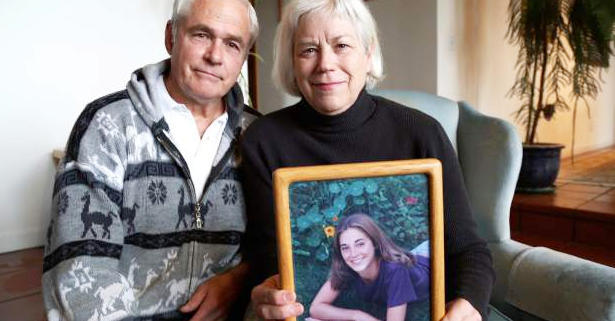 Nick and Amanda Wilcox of Penn Valley with a portrait of their daughter Laura, whose murder inspired "Laura's Law." (Photo, Laura Mahaffy, The Union)
Nick and Amanda Wilcox of Penn Valley with a portrait of their daughter Laura, whose murder inspired "Laura's Law." (Photo, Laura Mahaffy, The Union)In a significant policy shift spanning nearly two decades, 30 counties in California – including all of the larger counties, with an estimated 80 percent of the state’s population – have now adopted a 2002 state law giving families a legal avenue to get severely mentally ill relatives into treatment.
That’s 10 more than had previously adopted “Laura’s Law” in the 19 years since it was originally enacted, inspired by the Nevada County murder of a young woman by a mentally ill gunman. The law has received growing public support, and legislation was passed unanimously last year to strengthen the law and finally make it permanent.
“It’s a remarkable turnaround,” said Randall Hagar, longtime legislative advocate for the state’s psychiatrists and the father of a severely mentally ill adult son. “It’s been 20 years in the offing, and it opens the door for many families… It’s just the beginning, really, of finding better solutions.”
Efforts to update the highly restrictive law – often called the “third rail” of mental-health policy – have mostly failed over the years.
Of California’s 58 counties, 30 have adopted Laura’s Law, 24 have rejected it and four remain undecided. Counties could still “opt in” before the new law takes effect July 1.
Battling stigma, misconceptions and heartache, family members and mental-health policy experts have slogged through decades of controversy to convince legislators and local officials that supporting court-ordered intensive treatment – “Laura’s Law” in California — was not a return to the notoriously abusive system of state mental hospitals, where thousands of people were involuntarily housed, often for years, even decades.
It was a particularly ugly chapter in the tortured history of mental-health care in California. Hospital “residents” were routinely overmedicated, neglected, suffered injuries or death, too often under “suspicious” circumstances. The legislative solution, when it finally came in the form of the 1967 Lanterman-Petris-Short (LPS) law, severely limited involuntary treatment and has guided California mental-health policy, largely unchanged, for decades.
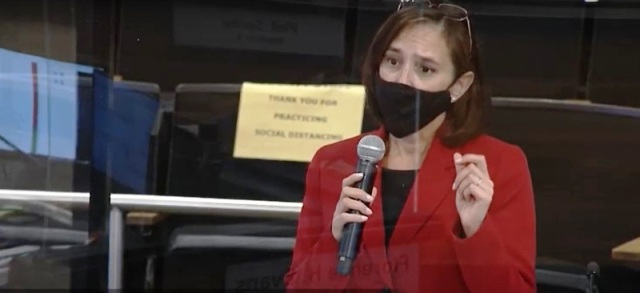
Chevon Kothari, Sacramento County’s director of health services, addressing the Board of Supervisors in May. The board adopted “Laura’s Law.” (MetroCable)
Efforts to update the highly restrictive law – often called the “third rail” of mental-health policy – have mostly failed over the years, although recent legislation, energized by a sharply critical state Auditor’s report last year, is beginning to change that.
“There has never been a point in time in which the interest in getting this right has been so keen, among the general public as well as elected policy makers,” said Hagar, who has labored in the trenches of mental-health policy and legislation for decades. “That gives us hope that we can make the system more responsive and provide the services people deserve.”
Many are severely, clinically ill, often self-medicating with street drugs, refusing help, so sick they are unaware of the severity of their condition.
It helps to understand the history. Following widespread news reports and multiple state investigations of abuse and deaths, the state mental hospitals were largely closed in the 1960s and ‘70s, and now house primarily those deemed criminally insane by the courts.
The “community care” which was vaguely envisioned but not specifically required by LPS, never materialized for the vast numbers of formerly institutionalized mentally ill Californians, leaving them — and their families — to fend for themselves, often with disastrous results.
The failures of the state’s fractured mental-health policies and laws are starkly visible today in cities throughout California, where an intractable, ever-growing population of homeless mentally ill people wander the streets — overwhelming hospital emergency rooms, cycling through jails and prisons ill-equipped to house, much less help, them.
Many are severely, clinically ill, often self-medicating with street drugs, refusing help, so sick they are unaware of the severity of their condition (called “anosognosia” in clinical terms). Although few become violent or commit serious crimes – they are much more likely to be victims of crimes — those that do dominate the headlines, reinforcing entrenched stereotypes, fear and stigma.
Early intervention a growing focus
One of those notorious cases served to illustrate why early intervention – a growing focus of both public policy and legislation — is essential.
Laura Wilcox, for whom “Laura’s Law” is named, was 19, working in a Nevada County mental health clinic in 2001, during her winter break from college, when the high school valedictorian and two others were killed and three people seriously injured during a psychotic rampage by a clinic patient.
Disability rights activists testified vehemently against the law, saying it violated the right to refuse treatment.
The family of the killer, Scott Thorpe, had desperately tried to convince Nevada County mental health authorities to intervene in the weeks before the murders, but were ignored.
During a lengthy trial, Thorpe, now 60, ultimately pleaded not guilty by reason of insanity and was sentenced to Napa State Hospital, where he will likely spend the rest of his life. Laura’s parents, Amanda and Nick Wilcox of Penn Valley, joined forces with legal and policy experts – and Thorpe’s family, including a brother who was a Sacramento police sergeant — to change the law.
It would become a 20-year battle for Laura’s parents, who tirelessly lobbied legislators and local officials, many of whom opposed any legislation they perceived to infringe on the rights of the mentally ill.
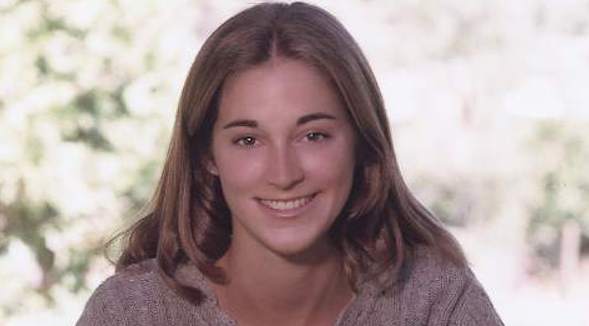
Laura Wilcox, whose shooting death in Nevada County inspired “Laura’s Law.” (Family photo)
Disability rights activists testified vehemently against the law, saying it violated the right to refuse treatment. They held noisy demonstrations on the Capitol lawn and in hearings on the original bill, many wearing yellow t-shirts with the triangular symbol for concentration-camp inmates deemed “mentally defective.”
Then-state Assemblywoman Helen Thomson, D-Davis, a former psychiatric nurse and Yolo County supervisor who is the author of the original law, was heckled and called “Nurse Ratched,” after the abusive nurse in Ken Kesey’s “One Flew over the Cuckoo’s Nest,” about a fictional psychiatric hospital.
“Some of those early hearings were uncomfortable,” recalled Nick Wilcox, then an environmental scientist for the state Water Resources Control Board. “We were personally accused of being ‘violence mongers’ and ‘spreading stigma’. The first time I testified in 2001, I told the Assembly Judiciary Committee that I believe in civil rights. But when your civil rights interfere with someone’s right to live, it’s gone too far. Laura had a right to live.”
By last year, after nearly two decades, 20 of California’s 58 counties had adopted Assisted Outpatient Treatment (AOT or Laura’s Law in California).
The resulting bill, while ground-breaking, was not a mandate – counties could quietly “opt out,” as most did – and it included no funding, which guaranteed county resistance. It also carried a “sunset” provision, which meant additional hearings were required to renew it every five years.
By last year, after nearly two decades, 20 of California’s 58 counties had adopted Assisted Outpatient Treatment (AOT or Laura’s Law in California). Those that did, including most of the state’s large counties, reported strikingly positive results in sharply reduced hospitalization, incarceration and homelessness, as well as significant cost savings. In San Francisco alone, savings of $400,000 a month were reported.
Then-Assemblywoman, now state Sen. Susan Talamantes Eggman, D-Stockton, introduced legislation last year which significantly strengthened Laura’s Law, adding judges to the list of those who could make referrals, streamlining the procedures for county action, and finally making the law permanent. Unanimously passed in both houses of the state Legislature, and quickly signed by Gov. Newsom last September, AB 1976 represented a major reversal of mental health policy over decades.
“The human rights and public-health crisis is not fair to families, and I think it has become a stark reality for everybody.” — Susan Talamantes Eggman
Opposition remained, mostly from disability rights groups who were considerably less vocal than during those raucous hearings about the original law.
‘A wildfire in our streets’
Likening the mental-health crisis playing out in plain view throughout California to “a wildfire in our streets,” Eggman noted growing support for major policy improvements in the state’s historically patchwork mental-health care system, brought into even sharper relief by a global pandemic and an epidemic of homelessness.
“How is that dignity for anybody?” said Eggman, a former social worker and Sacramento State social work professor, in an interview with Capitol Weekly last year.
“The human rights and public-health crisis is not fair to families, and I think it has become a stark reality for everybody. Now is a good time. We are passing things we’ve never passed before.”
And that momentum continues during the current session, with several bills sailing through the Legislature to further strengthen Laura’s Law and revise some provisions of the long-outdated LPS law.
“Many of us, myself included, have evolved in our thinking on Laura’s Law.” — Phil Serna
Rather than being able to quietly “opt out” of AOT, counties now are required by AB 1976 to hold public hearings, which became particularly intense in recent months as counties without Laura’s Law programs faced looming state deadlines to formally “opt out,” with specific reasons why, or be automatically “opted in.”
The state Department of Health Care Services (DHCS) gave the counties until May 15 to make their decisions, and many did, but several asked for extensions of that deadline. Under the law, counties deciding to implement programs must prepare plans to do so — or formally “opt out” — by July 1.
Nowhere has the debate over the newly strengthened Laura’s Law been more intense than in Sacramento and Santa Clara counties, the only two large counties which did not have such programs. In a complete reversal of decades-old opposition, county supervisors in both counties unanimously adopted Laura’s Law in May, following months of public hearings, online surveys and reams of written public comments.

A homeless man in Sacramento’s Cesar Chavez Park, across the street from City Hall. (Photo: Supervisor Phil Serna)
“Many of us, myself included, have evolved in our thinking on Laura’s Law,” Sacramento Supervisor Phil Serna said in a lengthy May 18 board meeting. “I am convinced it is the right thing to do, for the right reasons, to help people who are suffering, to help families.”
Sacramento board chair Sue Frost, a former emergency room nurse who had long opposed the law, said she too was convinced, pointing to other Laura’s Law counties with successful programs that have saved public funds, and lives. “Criminalizing mental illness is not the right path,” she said.
“It’s getting harder and harder to justify opting out when 20 different counties across the state have already implemented this program…” — Joe Simitian
“I’ve had concerns in the past about civil liberties and due process issues with AOT,” Santa Clara County Supervisor Joe Simitian, who voted for Laura’s Law as a state legislator in 2002, said in a written statement prior to the May 25 board vote. “But I’m now convinced that the law is crafted narrowly enough, and has enough protections built into it, that these concerns have been alleviated.”
Simitian echoed other local officials around the state when he noted the positive results of AOT programs in other counties.
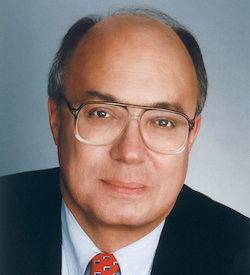
Santa Clara County Supervisor Joe Simitian.
“We now have the benefit of their experience,” he said. “It’s getting harder and harder to justify opting out when 20 different counties across the state have already implemented this program and can show that they are having real, positive effects on reducing psychiatric emergency services, crisis episodes, and hospitalizations.”
The newest member of the Sacramento board, Rich Desmond, said his long career in law enforcement, as a California Highway Patrol officer and administrator, often put him in situations involving mentally ill residents, when he had few options.
“I recall many situations when we either had a 5150 hold (the state code section for 72-hour involuntary LPS “holds” for those deemed a danger to themselves or others), or a criminal charge. There was nothing in between.”
Public support for Laura’s Law has grown exponentially in recent years, as more programs have been adopted in California — and in 46 other states.
Representing the Arden-Arcade area of Sacramento County, which has been particularly hard hit by homeless street encampments, Desmond said he and his daughter were recently driving through the area when they encountered “a clearly mentally ill individual,” and she asked, “Dad, can’t we do something?”
“We now have an opportunity to do something here in Sacramento County,” Desmond said. “It’s not a panacea, but part of a continuum, a tool that allows us to save some people who are in desperation.”
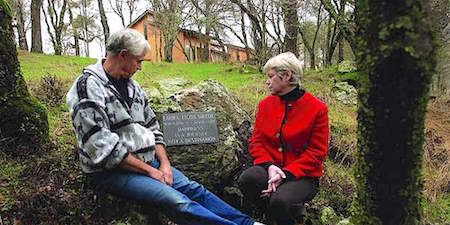
Nick and Amanda Wilcox at a memorial for their daughter, Laura. (Laura Mahaffy, The Union)
Public support for Laura’s Law has grown exponentially in recent years, as more programs have been adopted in California — and in 46 other states, according to the Treatment Advocacy Center, a national mental-health advocacy organization which has worked to develop AOT programs throughout the country, with widespread success but varying levels of government support, funding and oversight. Laura’s Law is based on a similar New York law – Kendra’s Law, named for a young woman who was pushed to her death from a subway platform by a severely mentally ill man who had been repeatedly hospitalized. Unlike Laura’s Law, the New York law is mandated and funded statewide.
Based on DHCS numbers and local news accounts, the 10 “new” counties — Fresno, Humboldt, Kings, Mariposa, Napa, Riverside, Sacramento, Santa Clara, Siskiyou and Tulare – that have voted to start AOT programs since the passage of AB 1976 last year, bring to 30 the total number of Laura’s Law counties. Twenty-four counties have voted to “opt out,” according to DHCS spokesman Anthony Cava, and four had yet to make a decision. Many of those have requested, and been granted, extensions by the state until July 1.
Too late for some families
The sharp increase in the number of California counties with AOT programs comes too late for some parents who believe their seriously mentally ill adult children would have benefited from the law, if it had been available in their counties.
Authorities said they advised Hopper to file a restraining order against her daughter, so she could be arrested, which she refused to do.
Kaino Hopper, a Carmichael textile designer and mental health activist who teaches family support classes for the Sacramento chapter of the influential National Alliance on Mental Illness (NAMI), was interviewed at length by Capitol Weekly earlier this year, when her severely mentally ill, now 32-year-old daughter Christine was homeless on the streets, and her mother was desperately trying to get help for her.
Christine Hopper, who has lived with serious neurological and schizoaffective diagnoses since she was a teenager — and graduated in the top of her high school class – was a few units short of a UC-Davis sociology degree when her condition seriously deteriorated in recent years.

Christine Hopper (Family photo)
Existing county programs were ineffective, and Hopper was convinced the intensive, court-ordered treatment available through Laura’s Law could help her daughter, who refused treatment, and had become increasingly delusional and combative. In January, during major storms in Sacramento, Hopper said county sheriff’s deputies rebuffed her efforts — and the strong recommendation of a licensed clinical social worker — to have her hospitalized on a 72-hour 5150 hold. She said they advised Hopper to file a restraining order against her daughter, so she could be arrested, which she refused to do.
A few months later, on April 19, Hopper was speaking in support of Laura’s Law during a Sacramento County public hearing, when she stunned the large virtual audience by announcing “with a very sad heart, that last week on April 14, Christine received a county service for her mental illness – incarceration.”
After allegedly attacking a male resident at an apartment complex where she once lived (he was not seriously injured and did not require treatment), she was charged with assault with a deadly weapon and jailed until May 11, when she was sent to the Sacramento County Mental Health Treatment Center and UC-Davis Medical Center on a 72-hour mental health hold. As a Kaiser member through Medi-Cal, she was transferred to Kaiser Hospital in Sacramento, which released her on May 14, at the end of the 72-hour hold, during which she refused treatment and would not speak with clinicians. Her release to the streets did not include a treatment plan or housing.
“This didn’t have to happen. Christine could have gotten better treatment long ago. AOT could have been the key. . .” — Kaino Hopper
Two days later, her mother learned, Christine had somehow made her way to the Central Coast, where she was treated in a San Luis Obispo hospital ER on May 16, and released the same day – at a cost of nearly $8,000. Hospital financial statements of public Medi-Cal benefits go to her parents’ Carmichael address, which is her legal address, and so far have amounted to at least $20,000 for three hospital visits in less than a week after she was released from jail. Back in Sacramento, she remains homeless on the streets, incapable of caring for herself.
“This didn’t have to happen,” Hopper added quietly. “Christine could have gotten better treatment long ago. AOT could have been the key. . .”
Hopper hopes her daughter’s case will be heard in Mental Health Court, “if she can last until the hearing on July 21.” Mental Health Court is a criminal court process in which defendants who qualify are diverted from the traditional court system into treatment. Laura’s Law is a civil court program to get severely mentally ill people into intensive treatment before they are arrested on criminal charges.
Susan McCrea was appointed to the Sacramento County Mental Health Board, which advises the board of supervisors on mental health policy, in 2008, drawn to accept the appointment because of her own family’s experiences. She currently serves on the county’s Mental Health Services Act Steering Committee, which advises the department of behavioral health on distribution of state MHSA funds raised by the 1 percent “millionaire’s tax” on incomes over $1 million, which was passed as Proposition 63 in 2004 and has since raised billions of dollars for mental health care in California.
She has strongly supported Laura’s Law throughout a frustrating, years-long series of failed attempts by supporters to convince supervisors to adopt the law, which might have helped her own daughter, Christianne.

Christianne McCrea. (Family photo)
“Our family witnessed Christianne’s increasing revolving door episodes of hospitalizations, missing person reports, incarcerations for minor offenses and even homelessness before she returned to our home in 2007,” McCrea wrote in a recent Sacramento Bee opinion article published shortly after Sacramento County finally, unanimously adopted Laura’s Law. “My presence on the Mental Health Board helped us navigate the intricate and often pockmarked mental health system in an attempt to help our daughter receive support during this wrenching, vicious cycle.”
In 2010, more than a decade after her first psychotic break at 22, and 11 years before Laura’s Law would be adopted in Sacramento County, Christianne Noel McCrea — “our beautiful Christmas Day child” — committed suicide. She was 33.
—
Editor’s Note: Sigrid Bathen is a Sacramento journalist and former Sacramento Bee reporter who taught journalism at Sacramento State for 32 years. She has long covered mental-health issues, for several publications, and her writing has won numerous awards. She has covered health care, education and state government for Capitol Weekly since 2005. Her web site is www.sigridbathen.com. She can be reached at [email protected].
Want to see more stories like this? Sign up for The Roundup, the free daily newsletter about California politics from the editors of Capitol Weekly. Stay up to date on the news you need to know.
Sign up below, then look for a confirmation email in your inbox.

Leave a Reply